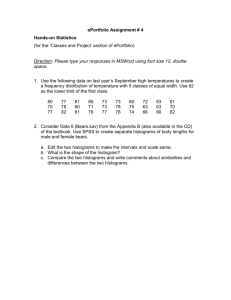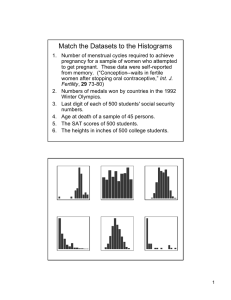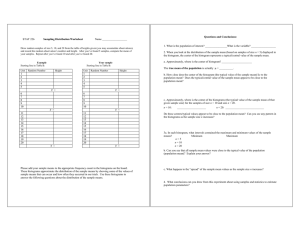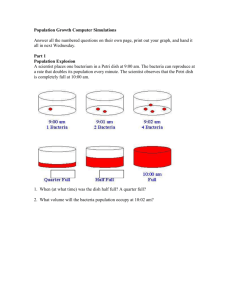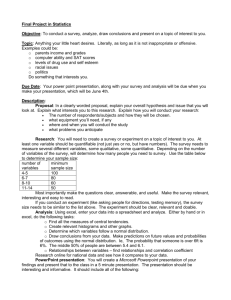XII. COMMUNICATIONS BIOPHYSICS Academic and Research Staff
advertisement
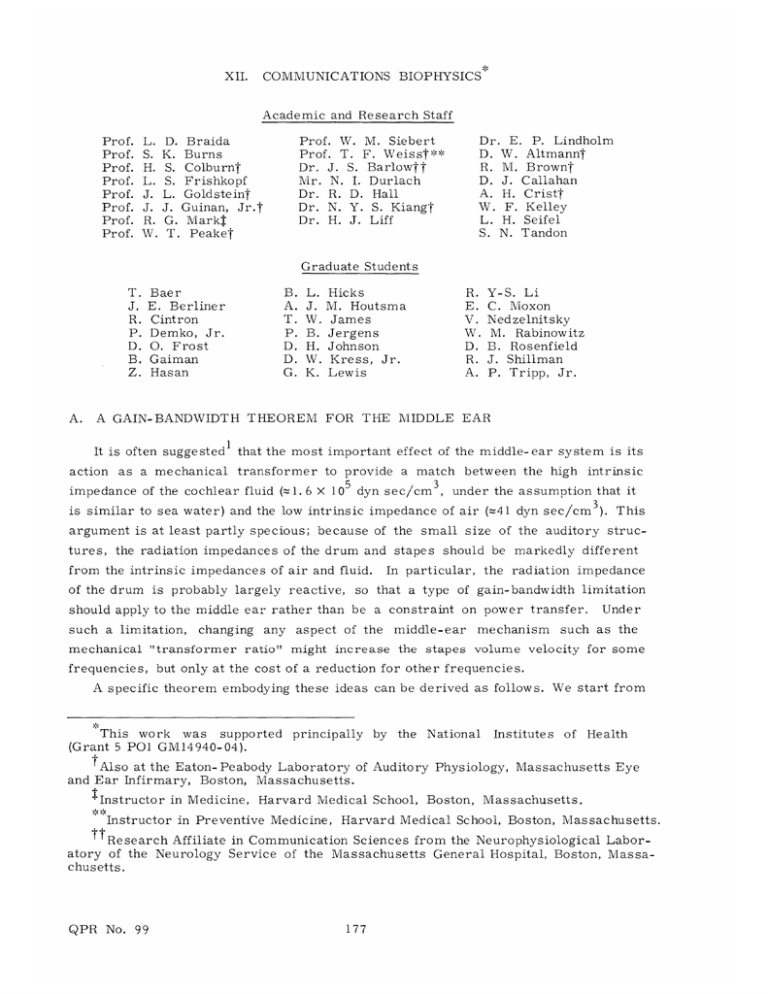
XII.
COMMUNICATIONS
BIOPHYSICS
Academic and Research Staff
Prof.
Prof.
Prof.
Prof.
Prof.
Prof.
Prof.
Prof.
L.
S.
H.
L.
J.
J.
R.
W.
Dr. E. P. Lindholm
D. W. Altmannt
R. M. Brownt
D. J. Callahan
A. H. Cristt
W. F. Kelley
L. H. Seifel
S. N. Tandon
Prof. W. M. Siebert
Prof. T. F. Weisstf**
Dr. J. S. Barlowtt
Mr. N. I. Durlach
Dr. R. D. Hall
Dr. N. Y. S. KiangT
Dr. H. J. Liff
D. Braida
K. Burns
S. Colburnt
S. Frishkopf
L. Goldsteint
J. Guinan, Jr.t
G. Markj
T. Peaket
Graduate Students
T.
J.
R.
P.
D.
B.
Z.
A.
Baer
E. Berliner
Cintron
Demko, Jr.
O. Frost
Gaiman
Hasan
B.
A.
T.
P.
D.
D.
G.
L.
J.
W.
B.
H.
W.
K.
A GAIN-BANDWIDTH THEOREM
It is often suggested
action
as a mechanical
Hicks
M. Houtsma
James
Jergens
Johnson
Kress, Jr.
Lewis
R.
E.
V.
W.
D.
R.
A.
Y-S. Li
C. Moxon
Nedzelnitsky
M. Rabinowitz
B. Rosenfield
J. Shillman
P. Tripp, Jr.
FOR THE MIDDLE EAR
that the most important effect of the middle-ear system is its
transformer to provide a match between the high
impedance of the cochlear fluid (l1. 6 X 105 dyn sec/cm
3,
intrinsic
under the assumption that it
is similar to sea water) and the low intrinsic impedance of air (=41 dyn sec/cm3).
This
argument is at least partly specious; because of the small size of the auditory structures, the radiation impedances of the drum and stapes should be markedly different
from the intrinsic impedances of air and fluid.
In particular, the radiation impedance
of the drum is probably largely reactive, so that a type of gain-bandwidth limitation
should apply to the middle ear rather than be a constraint on power transfer.
such a limitation,
changing
any aspect of the
mechanical "transformer ratio" might increase
frequencies,
middle-ear
mechanism
Under
such as the
the stapes volume velocity for some
but only at the cost of a reduction for other frequencies.
A specific theorem embodying these ideas can be derived as follows. We start from
This work was supported
(Grant 5 P01 GM14940-04).
principally
by the
National
Institutes
of Health
tAlso at the Eaton- Peabody Laboratory of Auditory Physiology, Massachusetts Eye
and Ear Infirmary, Boston, Massachusetts.
Instructor in Medicine,
Harvard Medical School, Boston, Massachusetts.
Instructor in Preventive Medicine, Harvard Medical School, Boston, Massachusetts.
ttResearch Affiliate in Communication Sciences from the Neurophysiological Laboratory of the Neurology Service of the Massachusetts General Hospital, Boston, Massachusetts.
QPR No. 99
177
(XII.
COMMUNICATIONS
BIOPHYSICS)
the fact that for any driving-point impedance,
2 =0 Re [Z(j)] -W
Z(s), such that Z(s) -
(1)
"
(This result is analogous to Bode's Resistance Integral theorem,
from integrating Z(1/)
Ls for small s
around the right-half a-plane).
circuit (voltage ~ pressure,
ear shown in Fig. XII-1.
2
and follows at once
Now consider the equivalent
current ~ volume velocity) for the mechanical parts of the
Here, Zm(jc) is the acoustic impedance (fundamental mode)
looking into the middle ear from a point just external to the drum membrane; Z a(jw)
and the pressure source Pg(O, 4, w) represent the Thdvenin equivalent circuit looking
outward
into the ear canal
for an incident
plane
sinusoidal
zo (iW)
acoustic wave of (rms)
0
W)
I vS(i
Pg (9, ,
Zm ( i)
W)
MIDDLE
-
-
Z (iz )
EAR
Fig. XII- 1.
pressure
[g(0,
P,
frequency w = ZTrf,
Equivalent circuit.
and the propagation direction determined by 0 and p
4, w) is closely related to the acoustic cross section of the ear and head 3 ]; and
V s ( jwc) is the (rms) volume velocity of the stapes which, when driving the cochlea,
presumed to present a load impedance,
To make use of (1),
z a (j)
At low frequencies
impedance
Zs(jw), to the middle-ear mechanism.
let
(jw)
(juo ) Z
Z
Z(jw) =
is
(2)
+ Zm (j)
it
is easy to show 3 that mass effects dominate in the radiation
Za(jw); i. e.,
Za(jw) - ju L a.
Since Z
(jw) is
a driving-point impedance,
it follows that, for low frequencies,
Z(jw) - jwL,
where L < L a .
QPR No. 99
(3)
The real part of Z(jw) is then constrained by (1).
178
(XII.
COMMUNICATIONS
BIOPHYSICS)
Finally, it follows from conservation of energy and the positive-real-function character of driving-point impedances that
Pg(O, 4,
Pg(O, 4,
1)
2
Z(jow)
Re [Z(ju)] >
R)
Re [Zm(jc)] >
I
Z (jw)+Z
Z (jw)
Vs(j)I
Re [Zs(j
where equality holds between the first two terms if Za(jw) is lossless (i. e.,
0),
],
(4)
(jow) 12
and between the last two terms if the middle-ear
Re [Za(j')]
system is lossless except for
Combining (1) and (4), we obtain
Zs (j)).
2
O0
V s(j L,) )
Pg(O,
(5)
K(w) du < i,
where
2 Z
Za(jw)
K(u) =
2
Re [Z (jw)
2
rcw
(6)
L
a
The inequality (5) is our principal result.
The significance of (5) depends sharply on the extent to which it is an approximate
equality.
Equality holds in (5) if the entire middle-ear system is lossless (except for
Z s(jw)), if Im [Za(jw)] >> Re [Z (jw)], and if Z (jw) is not zero at w = 0. There is some
a
3,4
If (5)
reason to believe that these are reasonable assumptions for the living ear.
is an approximate equality, then, since K(w) is not a function of any middle-ear parameter if Re [Zs(jw)] is attributed to the inner ear, improvements in transmission of the
middle-ear system at one frequency through changes in middle-ear parameters would
imply proportionate reductions (but not necessarily equal reductions if K(W) f constant)
at some other frequency.
From model studies, K(w) appears to be approximately con-
stant for low frequencies up to nearly the frequency
wavelength resonance of the external ear.
(~3-3. 5 kHz) of the quarter-
Near 3-3. 5 kHz, K(w) has a sharp peak. The
implications of this gain-bandwidth theorem, both for normal and pathological cases,
will be discussed in a later report.
W. M. Siebert
References
1.
E. G. Wever and M. Lawrence,
1954), Chap. 5.
2.
H. W. Bode, Network Analysis and Feedback Amplifier Design (D. Van Nostrand Company, New York, 1945).
W. M. Siebert, "Simple Model of the Impedance Matching Properties of the External Ear," Quarterly
Progress Report No. 96, Research Laboratory of Electronics, M. I. T., January 15, 1970, pp. 236-
3.
4.
Physiological Acoustics (Princeton University Press, Princeton, N. J.,
242.
A. R. Moller, "An Experimental Study of the Acoustic Impedance of the Middle Ear and Its Transmission Properties," Acta Oto-Laryngol. 60, 129-1 (1965).
QPR No. 99
179
(XII.
B.
COMMUNICATIONS
BIOPHYSICS)
ORGANIZATION OF THE POSTERIOR RAMUS AND GANGLION
OF THE VIIIth CRANIAL NERVE OF THE BULLFROG
RANA CATESBEIANA
The VIIIth cranial nerve of the bullfrog is known to consist of anterior and posterior
rami with their cell bodies of origin in the anterior and posterior ganglia, respectively.
Within the otic capsule each ramus divides into four branches that project to separate
sensory organs. As described in an earlier paper, 1 branches of the anterior ramus
innervate the saccular and utricular maculae, and the anterior and lateral canal cristae.
Branches of the posterior ramus innervate the basilar and amphibian papillae, lagenar
macula, and posterior canal crista. Study of the anatomy of the posterior ramus has
disclosed new details of its organization.
1.
Methods
a.
Bullfrogs (Rana catesbeiana) were perfused with formalin. The otic capsules
with VIIIth nerve and (in some cases) medulla attached were dissected. Specimens were
stained in toto by the Sudan Black B method of Rasmussen 2 and decalcified. The wall
of the capsule, portions of the membranous labyrinth, and connective tissue were carefully removed, leaving the nerves and sensory epithelia. The bundle of nerve fibers
to each end-organ could then be teased away from the rest of the nerve. In this way
the nerve bundles were separated through the ganglion and along the nerve to the medulla,
thereby making it possible to determine the relative positions of the separate branches.
The branches could also be detached and whole mounted on slides for more detailed
study.
b. Serial sections of the ear and VIIIth nerve in horizontal and cross-sectional
planes 3 were studied to confirm the results of dissections. The location and extent of
the VIIIth nerve ganglia, and, where possible, of the subganglia comprising them were
determined.
c.
Axonal degeneration techniques were employed. The posterior ramus was sectioned medial to the ganglion. The animals were sacrificed after one to two weeks and
the fibers were traced in the medulla using the Fink- Heimer modification of the Nauta
silver method 4 for staining degenerating axons.
2.
Results
Each branch of the posterior ramus is a separate nerve traceable from end-organ
through the ganglion to the medulla. Examination of whole mounts of dissected branches
reveals little gross damage to individual nerve fibers; this suggests that there is little
or no interweaving of fibers from different branches.
As each nerve branch enters the
QPR No. 99
ganglion it flattens into a band lying in a
180
-
I
(XII.
dorsorostral to ventrocaudal plane.
--
COMMUNICATIONS
I
BIOPHYSICS)
The ganglion cells of the nerve to the amphibian
papilla lie most dorsal and slightly caudal (Fig. XII-2).
The cell bodies of origin of
the nerves to the posterior vertical canal crista, basilar papilla, lagenar macula and
SAC.
P.C.
A.P.
ANT. /
B.P.
I.SAP.C.
P.C.
Fig. XII-2.
A.P.
Sketch of a dissected left VIIIth nerve of the bullfrog viewed
from ventro-medial showing the branches to the end-organs
and their relative positions just medial to the ganglion.
V = fifth cranial nerve; VII = seventh cranial nerve; S. SAC. =
superior saccular nerve; ANT. = anterior ramus; I. SAC. =
inferior saccular nerve; LAG.= lagenar nerve; B.P.=
basilar papilla nerve; P. C. = posterior canal nerve; A. P. =
amphibian papilla nerve.
inferior portion of the saccular macula lie successively more ventral in the posterior
ganglion.
The inferior saccular nerve courses along the caudal face of the anterior
ramus, with which it runs distally, and crosses just outside the capsule wall to its cells
of origin in the posterior ganglion.
ally with the anterior ramus.
The smaller superior saccular nerve courses medi-
The ganglia of the auditory (i. e.,
basilar and amphibian)
papillae lie lateral to the nerve cell bodies of the other branches of the posterior ramus.
QPR No. 99
181
-------
r
--
(XII.
~
I
r
I
I
--
I
COMMUNICATIONS BIOPHYSICS)
DORSAL
OPT. L.
\ , \"
\
(II/"!f/
,
"
CER.
A.P.
B.P.
MP.C.
!
!;
'
SiTROSTRAL
O. SAC.I
';.
LAG.
t
i
i
Fig. XII-3.
i
HYP.
Schematic of brainstem showing the cut end of the left
VIIIth nerve of the bullfrog viewed from lateral indicating
the extent and orientation of its branches as they enter
the medulla.
CER. = cerebellum; OPT. L. = optic lobe; HYP. = hypothalmus. (See Fig. XII-Z for other abbreviations.)
Proximal to the ganglion, the nerve branches maintain their relative positions until
they enter the brainstem (Fig. XII-3).
Preliminary study of the results of axonal degeneration methods show that some of
the fibers of the posterior ramus terminate within the small-celled dorsal and some
within the large celled ventral nuclear complexes in the medulla.
R. L. Boord, L. B. Grochow, L. S. Frishkopf
(Professor Robert L. Boord is in the Biology Department of the University of Delaware.)
References
1.
2.
3.
4.
C. D. Geisler, W. A. van Bergeijk, and L. S. Frishkopf, "The Inner Ear of the
Bullfrog," J. Morph. 114, 43-58 (1964).
G. L. Rasmussen, "A Method of Staining the Statoacoustic Nerve in Bulk with Sudan
Black B," Anat. Rec. 139, 465-468 (1961).
G. L. Rasmussen, M. M. Powers, and G. Clark, "A Simple and Reliable Trichrome
Stain," J. Neuropathol. and Exper. Neurol. 4, 189-192 (1945).
R. P. Fink and L. Heimer, "Two Methods for Selective Silver Impregnation of
Degenerating Axons and Their Synaptic Endings in the Central Nervous System,"
Brain Res. 4, 369-374 (1967).
QPR No. 99
-c~
182
re
(XII.
FIRING PATTERNS FOR REPETITIVE
AUDITORY-NERVE
C.
COMMUNICATIONS BIOPHYSICS)
PSEUDO NOISE-BURST STIMULI
Studies of the firing patterns of auditory-nerve fibers have been conducted with a
1-4
for tones, brief
variety of acoustic stimuli. In particular, data have been published
pulses (clicks), wideband random noise, and various combinations of these stimuli (two5
for
tones, paired clicks, tone and noise). Post stimulus-time (PST) histograms
Click responses are syn-
clicks and tones show a stable time structure of responses.
chronized to oscillations at the characteristic frequency (CF) for fibers with CF less
than approximately 5 kHz, and the time pattern of responses to low-frequency simple
tones shows a fine structure that is synchronized to the stimulating waveform. Tone
bursts have a transient variation in the envelope of the PST histogram in addition to the
fine structure. The envelope variation has a time constant of the order of 10 ms, and
When noise bursts are used as
presumably reflects some kind of adaptation effect.
stimuli, the PST histograms (using the onset time of the bursts as reference) have
about the same envelope shapes as the corresponding histograms for tone bursts. The
since these
time synchrony of responses to the fine structure is not evident, however,
It is not
histograms are averaged over responses to different, nonperiodic waveforms.
clear a priori what the expected pattern of the fine structure should be because some
4
tone complexes2,' 3 and paired clicks
wide-band stimuli (e. g.,
) result in complicated
response patterns that are not predicted by simple extrapolations of models for single
tones or clicks.
for
auditory-nerve
for
binaural
the
time
collaboration
those
described
of generating
the
be
investigated.
presented
modified
that,
waveform
noise.
of random
in
QPR No. 99
10
noise burst
6
The
per
slightly
that
to
shifted
when filtered,
signal was
second
bursts
allow
every
has
use
9.75
of 50 ms
and tones,
be
could
of
s.
with
duration;
a
method
computer-
generated,
so that
waveform
could
(Digital Equipment
accumulator
This produces
a
as
PST histograms
wideband
the
same
the
in the
many characteristics
lowpass-filtered
183
being
a computer
by
were
this way,
details of the
to the
was generated
stimulus
In
repetitively.
presented
responses
register
shift
13-bit
wideband
The
PDP-8)
Corporation
as a
of the
locking
clicks
for Audi-
Laboratory
procedure
only difference
to using
to the pseudo-random
responses
time
the
In addition
stimulus.
the
I
of
in
conducted
stimuli was
Eaton- Peabody
and experimental
by Kiang,
previously
noise burst was
generated
of the
preparation
The
Physiology.
tory
at the
N. Y. S. Kiang
Dr.
with
results
investigation
preliminary
noiselike
to wideband,
of responses
pattern
psychoacoustic
interesting
crude,
a
noise,
in
of signals
detection
of the
and because
models
responses
of
synchrony
of the time
details
of the
importance
of the
Because
10-kHz
of a
and link
a very
sample
cutoff and
every burst was the same,
(XII.
COMMUNICATIONS
since
the
register was
pseudo-noise
signal,
on magnetic
tape
BIOPHYSICS)
reset
the
to
the
starting
for later
same
pulses,
initial
value
and the
processing.
PST
before
neural
responses
histograms
resulting
pseudo-noise burst are shown at the left in Figs. XII-4, XII-5,
with
several
characteristic
polarities
of the
("CPNB")
for positive
These
The
stimulus,
histograms
comparison,
are
polated
histograms
sented
to facilitate
right
each
in
consistently
interpolated
versions
comparison
XII-4,
XII-5,
fiber.
the
for
both
"Condensation"
for negative
bar
same
stimuli.
histograms.
For
bin width as
the
inter-
histograms
are
pre-
Interpolated
simulation
chosen to
same
(Fig. XII-5) are shown in Fig. XII-7.
to the
and XII-6
the
results
and that
be
are
that are
discussed
approximately
(Indicated levels
are
dB
shown
below.
20 dB
relative
to
on
above
25
For
the
mV rms
at
earphone.)
has
detailed
time
a frequency
CF were
structure
as
characteristic
in the
peaks.
Fig. XII-7
set,
largest
istic
In general,
The
QPR No. 99
the
of the
gave
in
Note
i's.
allow
all
precise
with
compared
to
fine
CF
smaller
with the
corresponding
PST
be
of the
corresponding
chosen
indicated
histogram
of cycles
Variations
seen
to
amplitudes
shown
because
in
compared with
it
of
the
on the right
histograms
has
depend
histograms
small
bin widths are
illus-
responses
The
experiments.
of the
Fig. XII-6
well
of the
of tens
sufficiently
was
to
the
and can
bin widths
reproductions
Fig. XII-5,
in
during the
not
is
of the unit.
peaks
histograms
is
stimulus
structure
disagreements
that the
This
to the
on
shows
the left.
the
the highest character-
the
800-
chosen for this fiber.
the
obtained
since
to
on-line with tones
800
fiber
(z500 Hz);
observation
clicks,
sometimes
corresponds
tered in frequency
This
can be
roughly
present
are
that the
ps bin width for this fiber resulted in larger
when compared with bin widths of 400 and 200 p.s, and a bin width
jps was
waveform
evident
Bar histograms
changes.
frequency
of 400
are
data to
and
which
discrepancies
this
responses
separation
frequency.
and XII-5
individual
is
the
determined
variations
This
from
and phase
Figs. XII-4
It
of the
corresponds
to clicks;
CF
envelope
upon
that
determined
responses
with the
in
standard
Fig. XII-5.
with
level was
for that
correspond
left in
trated by the histograms.
in
of
from
results
labeled
("RPNB")
The
were recorded
and XII-6, for fibers
show
(but arbitrarily)
"Rarefaction"
on the left
fiber the noise
The
of
histograms
stimuli and
on the
Figs.
"threshold"
the
The
bar histograms for fiber K456-13
bar histograms
the
frequencies.
each burst.
the
interpolated
PST
by passing the
near the
CF
noise
of the
is not unexpected
PST
histograms
histograms
for these
bursts through
respective
on the
basis
for these
184
stimuli
results
can
resemble
narrow-band
fibers)
of
fibers
filters
followed by a
for
be
the
(cen-
rectifier.
simple
tones
described
by
and
the
CONDENSATION
SIMULATED
EXPERIMENTAL
0.5
0.4
0.3
0.2
1.0
0.1
0.5
0
I
I
I
r Ur
I
I
I
I
RAREFACTION
0.5
0.4
0.3
0.2
1.0
0.1
0.5
0
I
I
I
I
20
40
60
80
1
100
QPR No. 99
I
I
I
I
0
20
40
60
80
TIME (ms)
TIME (ms)
Fig. XII-4.
I
PST histograms for responses to pseudo-noise bursts.
Experimentally determined histograms are shown on
the left; simulated histograms are shown on the right
of the corresponding experimental histograms. Charof the fiber is approximately
acteristic frequency
(Note that the horizontal scales are different
340 Hz.
for left and right columns and that the vertical scale
on the right is arbitrary.)
185
I
100
CONDENSATION
EXPERIMENTAL
SIMULATED
0.8 0.6
-
0.4 0.2
1.0
-
0.5
I
I
I
I
I
0
I
I
RAREFACTI ON
:K456-13
RP1415
-11300B
V.
BRR5. 0 TO 1 2!5
BW. :800 MICSIM5.
2005
0.8
..........
0.6
..........
0.4
1.0 -
0.2
0.5 . . .. .. .
. . ..
0
20
40
60
80
100
TIME (ms)
Fig. XII-5.
QPR No. 99
I
I
I
I
1
1
0
20
40
60
80
100
TIME (ms)
PST histograms for responses to pseudo-noise bursts.
Experimentally determined histograms are shown on
the left; simulated histograms are shown on the right
of the corresponding experimental histograms. Characteristic frequ
en cy of the fiber is approximately
285 Hz. (Note that the horizontal scales are different
for left and right columns and that the vertical scale
on the right is arbitrary.)
186
CON DENSATI ON
EXPERIMENTAL
SIMULATED
0.5
0.4
0.3
1.0
0.2
0 5
.
0.1
0
RAREFACTION
0.5
0.4
0.3
1.0
0.2
0.5
0.1
I
I
I
I
I
I
I
I
I
I
I
I
0
10
20
30
40
50
0
10
20
30
40
50
TIME (ms)
Fig. XII-6.
QPR No. 99
TIME (ms)
PS'r histograms for responses to pseudo-noise bursts.
Experimentally determined histograms are shown on
the left; simulated histograms are shown on the right
of the corresponding experimental histograms. Charen cy of the fiber is approximately
acteristic frequ
465 Hz. (Note that the horizontal scales are different
for left and right columns and that the vertical scale
on the right is arbitrary.)
187
CONDENSATION
800 ps BIN WIDTH
K4 54
-1l
C-.F1l
400 ps BIN WIDTH
- •iiI 3 1 ,,,5
0.8
0.4
-- 0.6
0.3
.........
t; 0.4
0.2
Ln
I-
0.1
Z
0.2
LU
0
0
RAREF/ ACTION
0.8
0.4
- 0.6
0.3
0~20
n 0.4
200,5IM
4
0V.10
0.2
( ms )ms
80
I-
t
0.2
0.1
0
0
0
10
20
30
40
TIME (ms)
Fig. XII-7.
QPR No. 99
Bar PST histograms for fiber K456-13 in response to
pseudo-noise bursts. Left histograms have a bin width
of 800 4s. Right histograms have a bin width of 400 is.
(Note that vertical scales also differ between the columns.)
188
50
(XII.
COMMUNICATIONS BIOPHYSICS)
general relation
(t) * h(t)
* h(t)] exp r =A[s(t)
r = A[s(t)
h(t) exp * h(t)]
+ F[s(t)
where the asterisk indicates convolution; h(t) is the impulse response of a narrow-band
filter centered at the characteristic frequency of the unit; s(t) is the stimulus, and F and
A are slowly varying (10-ms time constant) functionals of s(t) * h(t). By choosing A
to be a constant equal to the spontaneous rate of firing and F a lowpass filtered envelope
of its argument, Siebert 7 has fitted the PST histograms for clicks (impulses) as a function of intensity for a fiber with low characteristic frequency (-500 Hz). Equation 1 then
reduces to
±Sh(t)
2)
xp
r = ASF[h(t)]
where S is the amplitude of the click stimulus, the plus sign is used for a condensation
8
click, and the minus sign for a rarefaction click. Evans has shown that the PST histograms for responses to low-frequency tones can be well described in the form
(3)
r = A exp{g cos (wt-O)},
where A, g, and 0 are functions of stimulus amplitude and frequency w. This is again
a special case of Eq. 1. When tone bursts are used as stimuli, it is necessary to allow
A and g to vary slowly (also consistent with Eq. 1) to show the transient effects at the
beginning and end of the bursts.
Applying Eq. 1 to noise bursts n(t) and ignoring the
variations, in A and F during the stimulus, we obtain the expression
(4)
r = A exp{±g[n(t) * h(t)]},
where A and g are constants.
With these motivations a crude test of the fit of Eq. 4 to the PST histograms from
this experiment was made. Equation 4 was simulated with h(t) determined to approximate the click-response PST histogram at low intensity. (According to Eq. 2, at low
intensities the PST histogram is described approximately by exp{Sh(t)} and can thus be
related to h(t).) The same shift-register sequence as used above was generated (not in
real time) on a different computer (Digital Equipment Corporation PDP-4) and digitally
filtered by convolving the noise sequence with the functions h(t). The resulting waveforms were exponentiated to give the functions shown at the right of the PST histograms
for each fiber and each polarity (plus sign for condensation, minus sign for rarefaction)
in Figs XII-4, XII-5 and XII-6.
QPR No. 99
189
(XII.
COMMUNICATIONS BIOPHYSICS)
The simulated histograms agree relatively well with the observed data from these
experiments.
The position and spacing of the peaks,
changes corresponding to the
polarity of the stimulus, and comparisons between histograms for fibers with different
characteristic frequencies are all consistent.
The relative peak heights also show good
agreement, even though this aspect of the simulated pattern is most sensitive to the specific choice of the filter impulse response h(t), and even though the relative peak heights
in the experimental histogram are somewhat affected by our choice of bin width. Note also
that the approximation of constant A and g in Eq. 4 changes the relative heights to some
degree;
in fact, other results of the simulation study show that Eq. 1 describes the data
better than Eq. 4.
For example, it is obvious that the AGC action of the denominator
of the exponent would increase the relative size of the first few peaks in the simulated
histograms and would result in a better fit to the data in every case shown, especially
for those shown in Fig. XII-5.
The results of this experiment offer limited support for the hypothesis that the PST
histograms in response to some wideband stimuli can be approximated by the form in
Eq.
1.
The results are also consistent with the recent work of de Boer
9
that is
based
upon crosscorrelation of the input waveform with the spike train on a single auditorynerve fiber when the input is a random-noise waveform.
however,
The rate function in Eq. 1,
cannot describe the results of Pfeiffer and Goblick 4 (who studied responses
of auditory-nerve fibers to stimulation with multiple clicks). Their results cannot be
explained by a linear filter followed by a nonlinearity. Similarly, paired-tone data2, 3
are dramatically inconsistent with the simple formulation in Eq.
further work is required to separate those stimuli for which Eq.
1.
It is
clear that
1 is a good approxi-
mation to the PST histogram from those stimuli for which the histogram cannot be
described by Eq.
is that Eq.
1.
One possible hypothesis that might be investigated, for example,
1 may be a good approximation for wideband stimuli whenever the spectrum
does not contain multiple maxima.
H. S. Colburn
References
1.
N. Y. S. Kiang, T. Watanabe, Eleanor C. Thomas, and Louise F. Clark, Discharge
Patterns of Single Fibers in the Cat's Auditory Nerve, Research Monograph 35 (The
M. I. T. Press, Cambridge, Mass., 1965).
2.
M. B. Sachs and N. Y. S. Kiang, "Two-Tone Inhibition in Auditory-Nerve
J. Acoust. Soc. Am. 43, 1120-1128 (1968).
3.
J. L. Goldstein and N. Y. S. Kiang, "Neural Correlates of the Aural Combination
Tone 2fl -f2," Proc. IEEE 56, 981-992 (1968).
4.
T. J. Goblick, Jr., and R. R. Pfeiffer, "Time-Domain Measurements of Cochlear Nonlinearities Using Combination Click Stimuli," J. Acoust. Soc. Am. 46, 924-938 (1969).
5.
G. L. Gerstein and N. Y. S. Kiang, "An Approach to the Quantitative Analysis of
Electrophysiological Data from Single Neurons," Biophys. J. 1, 15-28 (1960).
QPR No. 99
190
Fibers,"
(XII.
6.
D.
Zierler,
"Linear
Recurring
Sequences,"
COMMUNICATIONS BIOPHYSICS)
J.
Soc.
Industr.
Appl.
Math.
7, 31
(1959).
Siebert (Private communication from material to be published).
7.
W. M.
8.
J. E. Evans, "Time Pattern of Responses of Single Fibers in the Cat's Auditory
Nerve to Continuous Tones" (Private communication from material to be published).
9.
E. de Boer, "Correlation Studies Applied to the
Cochlea," J. Auditory Res. 7, 209-217 (1967).
QPR No. 99
191
Frequency
Resolution
of the
